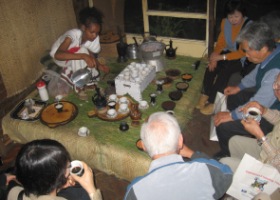
Ingera, the most common
food
The national dish for most Ethiopians is ingera, a flat, sour
dough pancake made from a cereal grain that is unique known as Teff.
Though t'eff is unique to Ethiopia it is diverse in color and habitat. Teff is
a member of the grass genus Eragrostis or lovegrass. T'eff will grow in many areas
it is not an easy crop to farm. One problem in particular is that the weight of
the grain bends the stem to the ground.
Fortunately for the Ethiopian Jews
(and all Ethiopians) depends on Teff Ingera, as a staple of their diet. Teff is
nutritional miracle food. It contains two to three times the iron of wheat or
barley. The calcium, potassium and other essential minerals are also many times
what would be found in an equal amount of other grains. Teff has 14% protein,
3% fat and 81% complex carbohydrate.
Teff is the only grain to have symbiotic
yeast. Like grapes, the yeast is on the grain so no yeast is added in the preparation
of ingera.
Teff is milled to flour and made into batter. The batter is allowed
to sit so the yeast can become active. When the batter is ready it is poured on
a large flat oven and allowed to cook. This process is much harder than it sounds
and it is recommended buying from an Ethiopian Market or Restaurant in your area.
Make sure it is Teff Ingera not a substitute Western ingera grains.
Ingera
is served with either meat or vegetable sauces.
One
tears of a bit of injera, and uses it to pick up pieces of meat or to mop up the
sauce. Berbere, the blend of spices, which gives Ethiopian food its characteristic
taste, can be hot for the uninitiated, although vindaloo or hot curry aficionados
will not have any problem. When eating national food Ethiopians eat together,
off one large circular plate. Visitors and guests will have choice morsels
and pieces of meat placed in front of them, and when eating doro wot, Chicken
stew, the pieces of meat are eaten last, after one has filled up on injera and
sauce. (If one were to finish the pieces of meat immediately, other bits
would be added.) Vegetarians should try "fasting food", what Orthodox
Christians eat during Lent and other fasting periods, and which is free of meat
and animal products. You eat with your right hand, and should always wash
your hands before eating - usually, a jug, basin and bar of soap are brought for
that purpose but in a restaurant you should make your way to the toilets.
For those who find Ethiopian food too spicy, in Addis Ababa there are now Greek,
Chinese, Armenian, Indian, Arabic, French and Italian restaurants. Outside
Addis Ababa, European style food, particularly pasta, is available in all the
large hotels.
DRINKS
Ethiopian
produced its own wines - Dukam and Gouder are good, dry reds, Crystal is a dry
white and Axumite is a sweet red - and spirits, like gin, ouzo and brandy.
There are also traditional alcoholic beverages: in Amharigna, generally
understood throughout the country, they are called tela (a local beer made from
grain), tej (honey wine or mead) and kati kala (distilled liquor).
ETHIOPIAN
COFFEE
The story of coffee has its beginnings in Ethiopia,
the original home of the coffee plant, coffee arabica, which still grows wild
in the forest of the highlands. While nobody is sure exactly how coffee was originally
discovered as a beverage, it is believed that its cultivation and use began as
early as the 9th century. Some authorities claim that it was cultivated in the
Yemen earlier, around AD 575. The only thing that seems certain is that it originated
in Ethiopia, from where it traveled to the Yemen about 600 years ago, and from
Arabia it began its journey around the world.
Among the many legends
that have developed concerning the origin of coffee, one of the most popular account
is that of Kaldi, an Abyssinian goatherd, who lived around AD 850. One day he
observed his goats behaving in abnormally exuberant manner, skipping, rearing
on their hindlegs and bleating loudly. He noticed they were eating the bright
red berries that grew on the green bushes nearby.
Kaldi tried a few
himself, ad soon felt a novel sense of elation. He filled his pockets with the
berries and ran home to announce his discovery to his wife. ‘ They are heaven-sent,
’ she declared. ‘ You must take them to the Monks in the monastery.
’
Kaldi presented the chief Monk with a handful of berries and related
his discovery of their miraculous effect. ‘ Devil’s work! ’
exclaimed the monk, and hurled the berries in the fire.
Within minutes
the monastery filled with the heavenly aroma of roasting beans, and the other
monks gathered to investigate. The beans were raked from the fire and crushed
to extinguish the embers. The Monk ordered the grains to be placed in the ewer
and covered with hot water to preserve their goodness. That night the monks sat
up drinking the rich and fragrant brew, and from that day vowed they would drink
it daily to keep them awake during their long, nocturnal devotions.
While the legends attempt to condense the discovery of coffee and its development
as a beverage into one story, it is believed that the monks of Ethiopia may have
chewed on the berries as a stimulant for centuries before it was brewed as a hot
drink.
Another account suggests that coffee was brought to Arabia
from Ethiopia, by Sudanese slaves who chewed the berries en route to help them
survive the journey. There is some evidence that coffee was ground and mixed with
butter, and consumed like chocolate for sustenance, a method reportedly used by
the Galla tribe of Ethiopia, which lends some credence to the story of the Sudanese
slaves. The practice of mixing ground coffee beans with ghee (clarified butter)
persists to this day in some parts of Kaffa and Sidamo, two of the principle coffee
producing regions of Ethiopia,. And in Kaffa, from which its name derives, the
drink is brewed today with the addition of melted ghee which gives it a distinctive,
buttery flavor.
Coffee from Sidamo in the south has an unusual flavor and
is very popular, especially the beans known as Yirgacheffes. In many ways Ethiopian
coffee is unique, having neither excessive pungency nor the acidity of the Kenyan
brands. It is closest in character to the Mocha coffee of the Yemen, with which
it supposedly shares a common origin, and it cannot be high roasted or its character
is destroyed. The best Ethiopian coffee may be compared with the finest coffee
in the world, and premium washed arabica beans fetch high prices on the world
market. No visit to Ethiopia is complete without participating in the elaborate
coffee ceremony that is Ethiopia's traditional form of hospitality. Invariably
conducted by a beautiful young girl in traditional Ethiopian costume, the ceremonial
apparatus is arranged upon a bed of long grasses. The green beans are roasted
in a pan over a charcoal brazier, the rich aroma of coffee mingling with the heady
smell of incense that is always burned during the ceremony. The beans are then
pounded with a pestle and mortar, and the ground coffee then brewed in a black
pot with a narrow spout.
Traditional accompaniments are popcorn,
also roasted on the fire, and the coffee is sugared to be drunk from small handless
cups.
Such fascinating ranges of experience made Ethiopia a truly land
of discovery.

